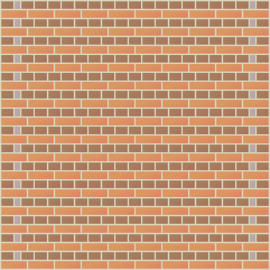Bricks Arrangement in Construction
Aim - Exploring different types of Brick arrangement types in Site Construction
Materials - Bricks, Cement, Sand, Water
Tools - Measuring Tape, Bowl, Level Tube, Spirit Level, Plumb Bob, Marking Rope.
Flemish Bond - This bond has one stretcher between headers, with the headers centred over the stretchers in the course below.
Header Bond - All bricks in this bond are headers, but for the lap-generating quoin three-quarter bat which offsets each successive course by half a header.
Header bond is often used on curving walls with a small radius of curvature. In Lewes, Sussex, England UK many small buildings are constructed in this bond, using blue coloured bricks and vitrified surfaces.
Stretcher Bond - All bricks in this bond are stretchers, with the bricks in each successive course staggered by half a stretcher. Headers are used as quoins on alternating stretching courses in order to achieve the necessary off-set.
It is the simplest repeating pattern, and will create a wall only one-half brick thick. Such a thin wall is not stable enough to stand alone, and must be tied to a supporting structure. This practice is common in modern buildings, where stretcher bonded brickwork may be the outer face of a cavity wall, or the facing to a timber or steel-framed structure.
English Bond - This bond has alternating stretching and heading courses, with the headers centered over the midpoint of the stretchers, and perpends in each alternate course aligned. Queen closers appear as the second brick, and the penultimate brick in heading courses. A muted colour scheme for occasional headers is sometimes used in English bond to lend a subtle texture to the brickwork. Examples of such schemes include blue-grey headers among otherwise red bricks—seen in the south of England—and light brown headers in a dark brown wall, more often found in parts of the north of England.
Rat Trap Bond - Rat-trap bond substantially observes the same pattern as Flemish bond, but consists of rowlocks and shiners instead of headers and stretchers. This gives a wall with an internal cavity bridged by the rowlocks, hence the reference to rat-traps.
The Bricks we used were 9*4*3.
Materials - Bricks, Cement, Sand, Water
Tools - Measuring Tape, Bowl, Level Tube, Spirit Level, Plumb Bob, Marking Rope.
Flemish Bond - This bond has one stretcher between headers, with the headers centred over the stretchers in the course below.
Header Bond - All bricks in this bond are headers, but for the lap-generating quoin three-quarter bat which offsets each successive course by half a header.
Header bond is often used on curving walls with a small radius of curvature. In Lewes, Sussex, England UK many small buildings are constructed in this bond, using blue coloured bricks and vitrified surfaces.
Stretcher Bond - All bricks in this bond are stretchers, with the bricks in each successive course staggered by half a stretcher. Headers are used as quoins on alternating stretching courses in order to achieve the necessary off-set.
It is the simplest repeating pattern, and will create a wall only one-half brick thick. Such a thin wall is not stable enough to stand alone, and must be tied to a supporting structure. This practice is common in modern buildings, where stretcher bonded brickwork may be the outer face of a cavity wall, or the facing to a timber or steel-framed structure.
English Bond - This bond has alternating stretching and heading courses, with the headers centered over the midpoint of the stretchers, and perpends in each alternate course aligned. Queen closers appear as the second brick, and the penultimate brick in heading courses. A muted colour scheme for occasional headers is sometimes used in English bond to lend a subtle texture to the brickwork. Examples of such schemes include blue-grey headers among otherwise red bricks—seen in the south of England—and light brown headers in a dark brown wall, more often found in parts of the north of England.
Rat Trap Bond - Rat-trap bond substantially observes the same pattern as Flemish bond, but consists of rowlocks and shiners instead of headers and stretchers. This gives a wall with an internal cavity bridged by the rowlocks, hence the reference to rat-traps.
The Bricks we used were 9*4*3.






Comments
Post a Comment